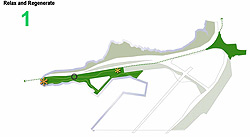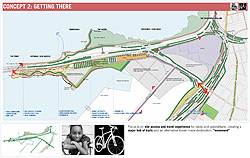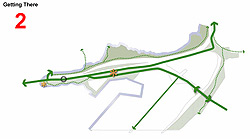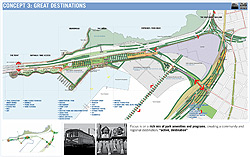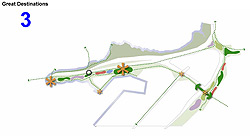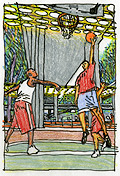
archive: three concepts
At the second public workshop on June 2, 2010, concepts were presented to explore a wide range of options for the site — from a quiet, natural setting focused on returning the site to its bayfront beauty, to a rich park experience that could offer features such as a gondola ride, kayak landing, trails, fishing pier, art, museum, and a destination restaurant.
We asked the community to tell us what is liked about each concept. In the next step, we will try to fit the favorite elements into a plan. This is more complex than fitting puzzle pieces together since some uses just don’t fit well side by side — no dogs romping through a wetlands preserve or freeway-bound cars passing by a playground. We will listen to your preferences and shape a new plan that we hope fits the desired character for the park and delivers features important to the community.
Three Concepts
The park concepts are designed to explore how best to nurture a natural setting, serve the area workers and West Oakland, and enhance the Bay Trail and Bay Bridge pedestrian and bicycle experience. Among the possibilities:
Concept 1: Relax and Regenerate would restore the industrial area to its natural beauty and generate new wetland areas
Concept 2: Getting There would create trails linking all of Oakland to the park and the future Bay Bridge bike and pedestrian experience
Concept 3: Great Destinations would offer a variety of ways to have fun at the park such as a Ferris wheel, gondola, art, or a destination restaurant
All three maps are divided into named areas that read from left to right: The Point, Baywalk/Bike Access, Boardwalk, The Green, Entrance/Park Road, and The Maze/West Oakland. This helped workshop participants to follow along more easily as the concepts were discussed.
Concept 1: Relax and Regenerate
Focus is on the visual and natural regeneration of site; place for enjoyment of natural features of the bay and site habitat; “passive, light touch”
|
Click on thumbnails to enlarge: This graphic shows the emphasis on site restoration, particularly
in two areas (colored green) with activity centers marked with
a gold asterisk. The point where the bridge touches down for pedestrian
and bicyclist access is marked with a dashed ring. |
Concept 2: Getting There
Focus is on making it safe and fun for green transportation modes (bikes/pedestrians/transit) to access the park.
|
Click on thumbnails to enlarge: This graphic shows the emphasis on an extensive trail system. The green lines and dashed green lines with arrows mark the trails, with activity centers shown with a gold asterisk. The point where the bridge touches down for pedestrian and bicyclist access is marked with a dashed ring. |
Concept 3: Great Destinations
Focus is on cultivating a varied park experience – learning at a museum or unique playground, a relaxing gondola ride to enjoy a breezy day, and dining at a waterfront “destination” restaurant.
![]()

